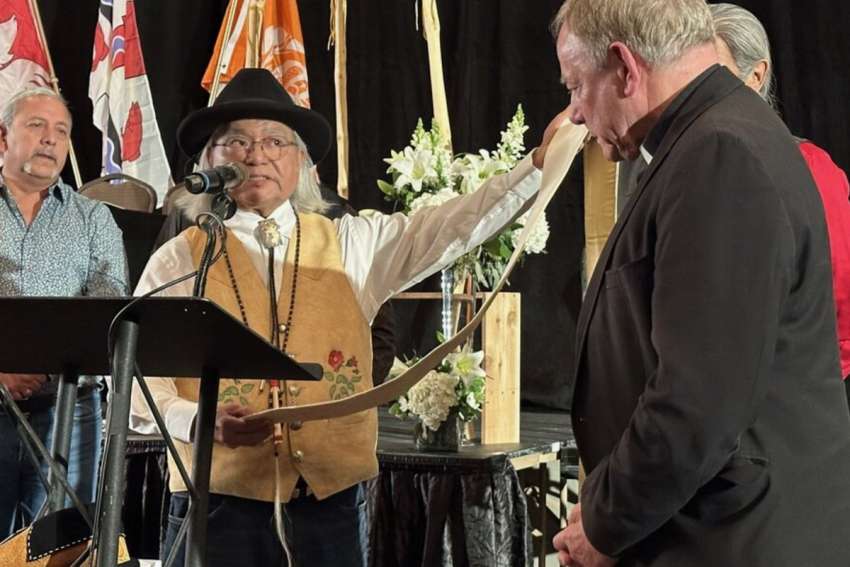But an open spirited reader of the concord made public June 21 will find a work of genuine beauty that is cause for authentic hope. Its achievement is all the more laudatory because of the conflagration of controversy from which it emerged.
Three years ago, beginning in May, 2021, Canada was thrown into a paroxysm of outrage, self-disgust and violent attacks on churches. Its catalyst was news that alleged the bodies of 215 children had been located using ground-penetrating radar on the site of the Kamloops school, which operated from 1890 until finally closing in 1969.
Indelible shame belongs to the despicable, hysteria-fanning, anger-monetizing recklessness of Canadian and international journalists who failed to ask essential questions about the allegations. Their failure catalyzed and perpetuated an atmosphere of dangerous delusion even as the Chief of the Tk’emlúps te Secwépemc Nation sought to clarify the findings.
Sharing the media’s disgrace is the cohort of political profiteers who exploited the destabilized emotions of that moment for their own vainglory and petty parliamentary advantage through grotesque dramatics of symbolic solidarity and the public shedding of lubricated tears that would make any self-respecting crocodile blush.
The resulting riven divisions could take decades to heal — if our nation can ever overcome them entirely.
Yet all who sincerely wish that healing to proceed and succeed should seek as their starting point the Sacred Covenant, which was meticulously, painstakingly and, above all, quietly negotiated through the almighty work of the Indigenous leadership, the Archdiocese of Vancouver and the Diocese of Kamloops.
In plainspoken language so characteristic of Indigenous peoples, inflected with traditional common law legalistic flourishes of “whereas” and “therefore,” the document sets out an agreed upon statement of historical facts. It commits the parties to mutually beneficial future actions. It does so with an utterly admirable absence of excitability that is always a sign of good faith acceptance of applicable responsibility. On that ground alone, it should be read as a teaching document for how healing and reconciliation are done.
It notes, without any note of triumphalist judgmentalism, that it was an amendment of the paternalistic Indian Act in 1920 that was the root of much evil at the residential schools.
The amendment gave “the Department of Indian Affairs the authority to require that all school-aged Aboriginal children attend either a day school or residential school. This enabled the Government of Canada to use financial and other systems to pressure Indigenous families to comply…. The objectives were based on the Government (emphasis added) assertion that Aboriginal cultures and beliefs were inferior and unequal.”
Holy Mother Church isn’t given easy absolution for the documented evils of some clergy and religious at the schools, or even for complicity in managing a system sunk deep in anti-Christian ideology. But the Covenant returns the focus of malfeasance where it properly belongs: On the State that pursued racist progressivism at the expense of God’s children.
It accomplishes something even more profound. It reminds us that what’s at stake is the sanctity of memories of children. Children. Children. To let that word sink in during the reading of the Covenant is to put in sane perspective debates over numbers and causes of death, over specificities of suffering and abuse, over percentages of outcomes good, bad and indifferent from the residential schools.
It brings back, hauntingly, the reality that little children were taken from their families — quantification of how forcibly is a distraction — and moved vast distances away… in the name of being educated. It sets the ground against which to comprehend the statistic derived by the Truth and Reconciliation Commission that about 3,200 of those children died at the schools from a variety of causes over a 150-year period.
Then it places in the frame of eight simple words why their fate must never be forgotten: “Many of these children died far from home.”
If we are Canadian patriots with imaginations, if we love this country for what it is, can be, but also despite the sins of what it has been, we will keep those words from the Sacred Covenant and, like Mary, ponder them in our hearts.
We need not indulge tawdry acts of self-flagellation so that we might, as Our Lord castigated, be like the hypocrites who stand in the street and pray so that they might be seen to do so. But we do have a covenantal obligation to remember.


